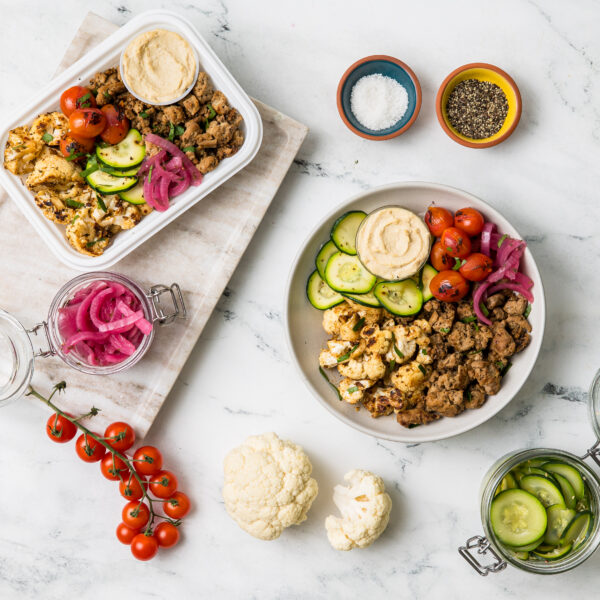There’s a lot of talk these days about plant-based diets, with some questioning the merits of eating animal protein at all. But what does the science say, and why do we care about protein anyway? Today, we’re breaking it all down for you, from the importance of protein to the differences between plant and animal protein.
Protein Basics
As far as I’m concerned, the importance of adequate protein intake isn’t talked about enough. Protein is crucial for everything from muscle strength and repair to boosting your metabolism.
- Protein is the most satiating macronutrient. It straight fills you up 👏! That’s because protein reduces ghrelin, a hormone that makes you feel hungry, and increases GLP-1, peptide YY, and cholecystokinin, all of which tell your body that you’re full. Given this, eating enough protein often helps decrease cravings for higher sugar and higher carb foods.
- Protein is also great for your bones and muscles. Many long-term studies show that people who consistently eat balanced amounts of protein can maintain bone mass better as they age—showing a reduction in hip fractures and instances of osteoporosis. Additionally, protein is the building block of your muscles. Many studies show the higher the daily protein intake, the better muscle gains you can experience when exercising or losing weight.
- Protein may help lower blood pressure. High blood pressure can be a scary thing. It increases your risk of stroke, heart attack, and diabetes. Thankfully, protein might be able to help with that. Protein has been shown to reduce both LDL and HDL cholesterol levels, blood pressure, and triglycerides. “In a review of 40 controlled trials, increased protein lowered systolic blood pressure (the top number of a reading) by 1.76 mm Hg on average and diastolic blood pressure (the bottom number of a reading) by 1.15 mm Hg”.
- Protein has a higher thermic effect of food (TEF) than other macronutrients. There are lots of things that help boost your metabolism—namely exercise and eating enough food. Eating boosts your metabolism quickly, but temporarily. And eating certain foods can cause you to burn more calories overall, boosting your metabolism in the process.
Protein has a higher TEF than its fat or carb counterparts: 20-35 percent. So how does this look in terms of calories? One study shows us that “High protein intake has been shown to significantly boost metabolism and increase the number of calories you burn. This can amount to 80–100 more calories burned each day”. You still don’t believe us? When studied altogether, “overweight women who ate 30% of their calories from protein lost 11 pounds (5 kg) in 12 weeks”, even without dietary restrictions.
You’re Likely Not Getting Enough Protein
Despite its importance, there’s a very good chance that you’re not eating enough protein. Yes, you! Recommended protein intake will be variable since we’re all different heights and weights and have vastly different activity levels. For example, given the demand they place on their muscles and tissues, an athlete will need more protein than the average person.
A good rule of thumb is to consume at least 30g of protein at each meal, but ideally between 30-50g. To put that in perspective, 1 ounce of protein is about 7g. If your goal is 30g/meal, you’ll need to eat at least 4oz of protein at each meal. Did you know that one egg is only considered an ounce of protein? That means you’d need to eat at least 4 eggs with breakfast to hit your goal, not the 1-2 that you’re probably eating now.
The best, most bioavailable (easiest for your body to digest and absorb!) forms of protein will be from animal products, like eggs, dairy, meat, seafood, and more. You can also get protein from plant sources, with foods like beans and other legumes, organic soy, or nuts and seeds. Just keep in mind that since many of these are a mix of carbs and protein, they won’t have the same high TEF that animal-based protein sources have.
Not only does protein have the highest TEF and have an anti-aging effect, but it is also the most satiating macronutrient. That means it keeps you full for longer, helps balance your hunger hormones, and even reduces cravings. It’s so important to eat enough! If you’re interested in reading more, we talked recently on the blog about the importance of eating enough protein.
All About Animal Protein
When we talk about the aforementioned benefits of protein, much of the research has been done using animal proteins. Animal proteins include the following:
- Chicken
- Beef
- Pork
- Fish and other seafood
- Wild game
- Eggs
Our bodies need 20 different amino acids, but can only create 11 of them, which means we need to find the other essentials elsewhere. Animal proteins are naturally complete, meaning they contain all nine essential amino acids.
All animal (and seafood!) sources of protein are highly nutrient-dense, containing B vitamins, zinc, omega-3s, and more, but quality does matter. Aim to eat the highest quality you can afford, opting for pasture-raised options whenever possible. And aim for variety, too, since all animal proteins will provide different nutrients. For example, red meat (despite being vilified!) has more nutrients per ounce (think B vitamins, omega-3s, CLA, and more) when compared to something like chicken.
All About Plant Protein
There aren’t many complete forms of plant protein, so you often have to mix and match to make a complete protein. Some options include:
- Beans & legumes
- Vegetables
- Soy
- Nuts & seeds
- Grains
It’s important to note that some plant proteins offer more carbs than protein. That’s true for beans & legumes as well as for grains. Given that, it’s important to balance your intake of overall carbs at meals to ensure you’re getting a reasonable balance of protein, carbs, and healthy fats.
It’s also important to balance your plate in other ways: while all animal proteins offer the 9 essential amino acids, very few plant proteins do (quinoa being one of the few). This means that to consume the range of necessary amino acids, you will also need to eat a range of plant proteins. The upside to this is that studies have repeatedly shown the benefits of increased vegetable consumption.
Plant protein sources also have an inherently lower count of amino acids and are harder to digest and absorb than animal protein. This leads to reduced protein synthesis, which is kicked into gear by the essential amino acids. If you’re trying to put on muscle mass or simply trying to eat enough protein, that means you’ll need to eat a lot more plant protein to try to hit your goals.
So, Which is Best?
This truly depends on your goals and personal preferences.
As always, we recommend pursuing a balance to enjoy the best of both worlds. Focus on high-quality meats and plenty of vegetables and healthy fats. If you are interested in delving further into your nutrition and what’s best for you, your doctor or a dietitian can be the best place to start.
In the meantime here at Snap Kitchen, we’ll support you no matter which foods you choose to eat. We’ll always be here offering a variety of proteins in our meals, designed to give your body the full breadth of nutrients it needs.





Leave a Reply
No Comments